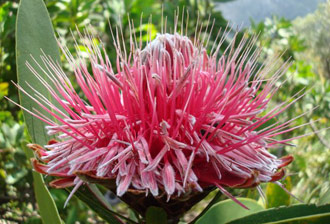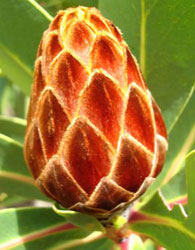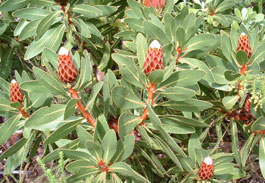Protea rubropilosa
Protea rubropilosa Beard
Family: Proteaceae
Common names: transvaal sugarbush, transvaal mountain protea, red velvet protea, escarpment protea (Eng.); transvaalbergsuikerbos (Afr.); segwapi (Sotho)
SA Tree No: 97
Introduction
The transvaal sugarbush is a striking protea. It has a neat habit and provides year round interest in the garden.

Description
Description
Protea rubropilosa forms a large shrub or tall tree depending on its growing conditions. Wild specimens ravaged by a harsh climate become gnarled ancient shrubs only reaching 1m, whereas plants grown in ideal conditions under cultivation can reach up to 8m. These are the extremes and normally plants grow between 2-4m tall. Cultivated plants have a spreading, rounded shape with foliage touching the ground.

Trunks and branches are stout with thick, chunky, deeply fissured bark. Old specimens can have trunks measuring up to 450mm in diameter. Flowering stems are smooth and when young are bright green turning to an attractive red brown with age. Big clusters of red new leaves appear in the beginning of the growing season. These leaves appear mainly on the tips of branches and contrast beautifully with the dark green older foliage. Leaves are long, smooth and have a rounded tip.

Individual flowerheads appear on the tips of branches in spring and early summer (September to December in South Africa). First to appear are rich red brown velvety buds with white fluffy tips of the perianth emerging from the bud soon after. They continue pushing open the bud until the bracts open up flat to reveal bright pink flowers guaranteed to catch your eye. After flowering the flowerhead closes up to mature the seeds which can be harvested from the plant 1 to 2 years after flowering.

P. rubropilosa is a slow grower but in protea terms is long-lived, surviving upwards of 60 years.
Conservation Status
Status
The Transvaal sugarbush is listed as Least Concern (LC) on the Red List of South African Plants, as it is a widespread, common species.
Distribution and habitat
Distribution description
This is a summer rainfall species from the Northern Province and Mpumalanga. It occurs in an arc along the Drakensberg escarpment from Wolkberg in the north to Lydenberg in the south.
Protea rubropilosa forms open woodlands growing alongside P. roupelliae. This habitat often has frequent fires that burn the lower trunks and branches of the trees leaving gnarled old trunks with sparse crowns of leaves. Soils are acidic originating from sandstone or quartzite. Plants grow on south facing slopes at altitudes of between 1 400-2 300m. The high altitude results in frequent mists and more than 1000mm of rain in summer.

Derivation of name and historical aspects
History
The first collection of Protea rubropilosa was made in 1917 by Rev. F.A. Rogers who was an avid collector working as a Chaplain to the South African Railways. Despite its early discovery this species was only described in 1958 by Dr. J.S. Beard.
Linnaeus named this genus in 1735 after Proteus, a god in Greek mythology. This god was able to transform himself into many different forms, not unlike the many different forms of proteas. Rubropilosa means short red hairs referring to the velvet red brown hairs on the outside of the bracts.
There are 114 members in the genus Protea, 82 of which are found in South Africa; 13 of these are from the summer rainfall region, but the majority (69 species); occur within the winter rainfall region. The iconic Protea cynaroides is the most well-known and popular member of the Protea family and is South Africa's national flower.
Ecology
Ecology
Protea rubropilosa is pollinated by birds but flowers are also visited by an array of insects and bees.
The thick, corky bark found on older plants serves as protection against the frequent fires. The outside of the bark burns but plants are able to stay alive and resprout new leaves from buds hidden beneath the bark.
These new leaves are very soft and would make excellent food for hungry insects. It is thought that they are coloured red for 2 reasons: red reflects the sun's heat and helps to prevent leaves from drying out; and secondly insects cannot see red so hopefully won't eat the new growth.
Uses
Use
There are no known cultural uses for Protea rubropilosa . It is a slow growing species so is not widely used in horticulture but definitely deserves a place in the collector's garden.
Examples of proteas used culturally include the Waboom, Protea nitida, whose wood was used to make the wagon wheels, brake blocks, butter bowls, tripod stools and pot stands. Nectar extracted from P. repens was made into 'bossiestroop' by the early Cape Colonists. This clear syrup was used as a sweetening agent and for the treatment of coughs and colds.

Growing Protea rubropilosa
Grow
Protea rubropilosa, once established, is a wonderful species of protea to grow in the garden. It does seem to be tolerant of conditions different to its natural habitat as plants at Kirstenbosch receive no water through the summer months and lots of water during the winter months. I would think as long as plants receive enough water and have well-drained acidic sandy soils that they would grow well in other garden situations.
The Transvaal sugarbush is rather slow growing and 8 years after germination from seed plants will have reached 1,5m and flower for the first time. A long term investment! While young, plants only need to be lightly pruned to shape. If you are lucky enough to have mature plants with thick corky bark in your garden you can give them a hard prune to stimulate new growth and encourage side shoots along the trunk of the tree.
The best time to plant new plants into the garden is at the start of the rainy season. This enables plants to establish themselves and send down deep roots before the hot, dry, summer season. Protea rubropilosa requires a sunny situation with well-drained soil. In nature plants grow together in large open groups. If you have a large garden you can copy this by making an informal woodland together with other summer rainfall proteas. Adding bulbs and small perennials to the grassland beneath would create wonderful effect. P. rubropilosa can also be used in the traditional fynbos garden or planted as a feature specimen.
Propagate Protea rubropilosa from cuttings or seed. Neither option is easy but seed generally has a higher success rate than cuttings. Sow seeds in autumn or spring when the nights are cool and the days warm. Treat the seeds with a systemic fungicide and plant into open beds or seedling trays. Use a well-drained fynbos mix consisting of 1 part loam, 1 part bark, and 2 parts sand. Cover the seeds lightly with sand or fine bark. This species germinates after ± 28 days, after which the growth is incredibly slow. Once two true leaves have grown, prick the seedlings out into small bags. Place the seedlings in a lightly shaded area with good air circulation. When plants are ± 100-150 mm tall, they can be planted into the garden.
Take cuttings from the current season's growth once they reach the semi-hardwood stage. It is quite hard to find good cutting material as the stems are very thick, try to find pencil-thickness material if possible. The cuttings should be 100-150 mm long. Dip the cuttings into a rooting hormone and plant in a mixture of 50 % polystyrene and 50 % bark. Place the cuttings under intermittent mist with a bottom heat of 25°C and good air circulation. Once the roots are well developed, remove from the mist unit and harden off for three weeks. Plant the cuttings into small bags and grow on until ready to plant into the garden.
Protea rubropilosa is a relatively hardy protea and not susceptible to too many diseases and pests in a garden situation. The most important factor in preventing disease in proteas is to make sure the environmental conditions are correct. This includes getting direct sunlight for the most of the day, a well-drained soil where the soil does not stay saturated and stagnate, and good air circulation ensuring that the above-ground parts of the plant dry quickly after watering. It is also important to ensure that the soil stays cool in the hot months and roots are not disturbed by excessive digging. A thick layer of mulch or groundcover planting can be used to keep the soil cool and prevent moisture loss. If any of these factors are not correct, the plants become weakened and stressed and you will be sure to attract some form of pest or disease.
References
- Raimondo, D., Von Staden, L., Foden, W., Victor, J.E., Helme, N.A., Turner, R.C., Kamundi, D.A. & Manyama, P.A. (eds) 2009. Red List of South African plants 2009. Strelitzia 25 . South African National Biodiversity Institute, Pretoria.
- Rebelo, A. (Tony). 2001. Proteas. A field guide to the proteas of southern Africa, edn 2. Fernwood Press, Cape Town.
- Rourke, J.P. 1982. The proteas of southern Africa. Centaur Publishers, Johannesburg.
- website: Protea Atlas Project. http://protea.worldonline.co.za.
Credits
Louise Nurrish
Kirstenbosch National Botanical Garden
November 2011
Plant Attributes:
Plant Type: Shrub, Tree
SA Distribution: Limpopo, Mpumalanga
Soil type: Sandy, Loam
Flowering season: Spring, Early Summer
PH: Acid, Neutral
Flower colour: Brown, Pink
Aspect: Full Sun
Gardening skill: Challenging
Special Features:
Horticultural zones











Rate this article
Article well written and informative
Rate this plant
Is this an interesting plant?
Login to add your Comment
Back to topNot registered yet? Click here to register.